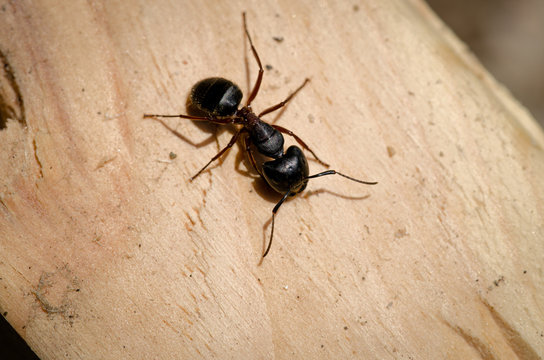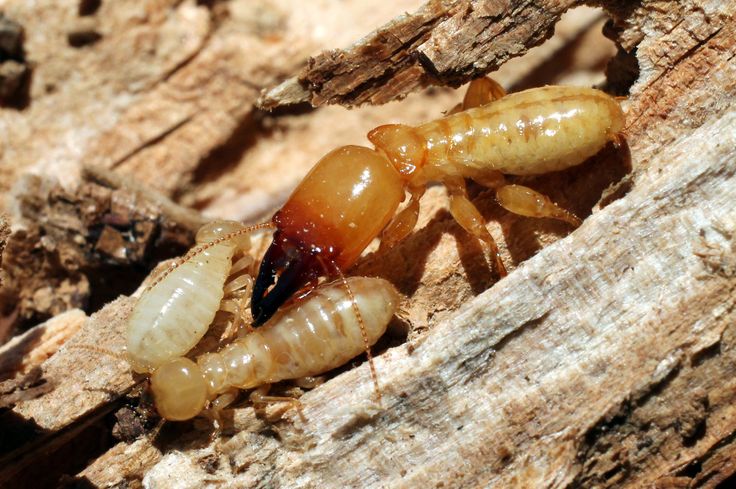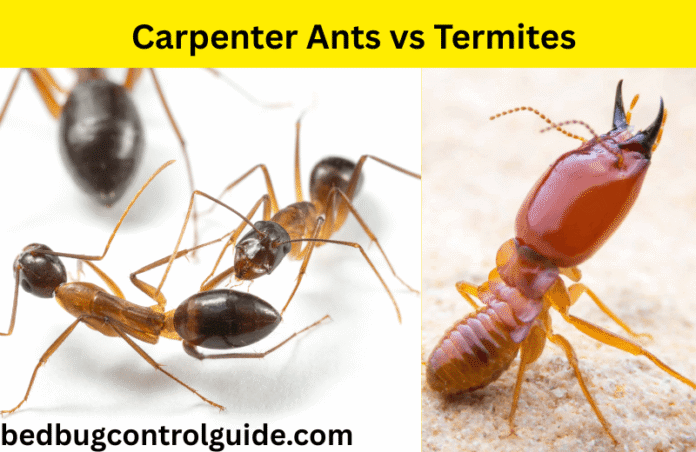When it comes to pests that damage wood, carpenter ants vs termites are often confused. While both can wreak havoc on a home, they behave differently and leave distinct signs. Knowing these differences can help protect your home and deal with infestations promptly. This guide will help you identify the signs of carpenter ants vs termites and understand their key differences.
Carpenter Ants & Termites Appearance
One of the easiest ways to distinguish between these pests is by their appearance. Both may look similar from afar, but a closer look reveals distinct differences.
Carpenter Ant Appearance

- Body shape: Carpenter ants have a pinched “waist,” giving their bodies a segmented look.
- Antennae: They have elbowed, bent antennae.
- Wings: If they have wings, the front wings are longer than the back wings.
- Color: Carpenter ants are typically black, reddish-brown, or a combination of red and black.
Termite Appearance

- Body shape: Termites have a straight, uniform body with no waist.
- Antennae: Their antennae are straight and look like small beads.
- Wings: Both sets of wings are the same size and extend beyond their body.
- Color: They are light brown to cream-colored, depending on the species.
By focusing on carpenter ant appearance and termite appearance, you can quickly identify which pest is invading your space. Read our latest post on Do Carpet Beetles Bites on Humans at Night? What You Need to Know in 2025
Damage Patterns
Carpenter ant damage and termite damage also differ significantly. These pests’ behavior with wood sets them apart and affects the extent of harm they cause.
Carpenter Ant Damage
- Carpenter ants do not eat wood. Instead, they excavate tunnels in it to make their nests.
- The tunnels they create are smooth and clean, often found in moist or decaying wood.
- Look for piles of sawdust-like material near their nesting sites. This is called frass, a mixture of wood shavings and debris. Yesterday, we published a post on How to Get Rid of Carpet Beetles in Your House?
Termite Damage
- Termites actually eat wood because they consume cellulose for sustenance.
- Their damage is often rough and extensive, weakening wood structures over time.
- Termites may create mud tubes, thin tunnels built with soil, wood particles, and saliva, to travel between their colony and wood.
Understanding these differences in damage can prevent costly delays in detecting and addressing infestations.
Read Our Most Recently Published Guides on Termites, Earwigs, Fruit Flies, Ants Control, Baby Termites, Carpenter Ants and Gnats:
- What Do Bed Bugs Look Like?
- Early Signs of Bed Bugs on Mattress? Explained in 2025
- Skin Early Signs of Bed Bugs? Identification, Prevention
- Baby Termites vs Ants? How to Tell the Difference
- How Big are Termites? How to Identify Termites and Treatment
- How to Get Rid of Plant Gnats Fast? Prevention and Treatment Tips
- How to Get Rid of Fungus Gnats in House Fast? Fungus Gnats Treatment Tips
- Are Earwigs Dangerous or Poisonous to Humans and Dogs?
- Why Are There Earwigs in My House? Prevention and Treatment Guide
Other Signs
Apart from appearance and wood damage, there are additional signs of carpenter ants and termite infestation signs to watch for in your home.
Signs of Carpenter Ants
- Foraging ants: You may spot large ants walking around your home, especially at night.
- Frass piles: Carpenter ants discard frass near their nests, leaving sawdust-like debris.
- Rustling sounds: You might hear faint noises inside walls if carpenter ants are burrowing.
Termite Infestation Signs
- Discarded wings: You may find piles of wings left by swarmers in windowsills or near lights.
- Hollow-sounding wood: Tapping wood may reveal a hollow sound if termites have been feeding inside.
- Bubbling or cracked paint: Termites inside walls can cause paint to peel or crack.
- Mud tubes: These visible tunnels are a sure sign of subterranean termites.
By paying attention to these clear signs of carpenter ants vs termites, you can identify and quickly address an infestation.
Key Differences Summary
Here’s a quick comparison to summarize the main differences between carpenter ants and termites:
| Feature | Carpenter Ants | Termites |
| Body Shape | Constricted waist, elbowed antennae | Straight body, straight antennae |
| Wings | Uneven length (front wings longer) | Equal length (all wings uniform) |
| Damage | Smooth tunnels, do not eat wood | Rough, extensive damage from wood-eating |
| Food Source | Does not eat wood | Consumes wood |
This simple breakdown makes it easier to spot the difference between these two wood-damaging pests.
How to Get Rid of Carpenter Ants and Termites
If you’ve identified a carpenter ant or termite infestation, immediate action is necessary to prevent further damage. Here are a few methods to consider:
1. For Carpenter Ants
- Eliminate the Nest: If you can locate the nest, use a borehole treatment to eliminate the ants. You may need professional pest control if the nest is difficult to find.
- Seal Entry Points: Caulk any gaps or cracks around doors, windows, and vents to prevent the ants from entering your home.
- Eliminate Moisture: Since carpenter ants prefer moist wood, fix any leaks and remove standing water to make your home less inviting.
2. For Termites
- Use Bait Stations or Liquid Termiticides: Termite bait stations are placed around your home’s foundation, while liquid termiticides are applied to the soil around your home to create a barrier.
- Professional Pest Control: Because termites cause structural damage, it’s often best to hire a professional pest control service to eliminate termites and prevent future infestations.
How to Prevent Carpenter Ants and Termites
Preventing carpenter ants and termites from entering your home involves taking some simple but essential steps:
1. Regular Inspections
Regularly inspect your home for signs of pest activity, especially in damp or hidden areas such as basements, attics, and crawl spaces.
2. Control Moisture Levels
Both carpenter ants and termites are attracted to moisture. Repair leaky pipes, install proper ventilation, and ensure good drainage around your home to keep wood dry and unattractive to pests.
3. Remove Wood Debris
Remove any wood debris, tree stumps, or dead trees from around your home, as these can attract both carpenter ants and termites.
4. Seal Cracks and Gaps
Seal all entry points around doors, windows, and foundations. Termites and carpenter ants can enter through even the smallest gaps.
Conclusion
Being able to differentiate carpenter ants vs termites can save your home from damage and costly repairs. While carpenter ants build tunnels in wood, termites consume it, leading to severe structural problems. If you notice any of the signs of carpenter ants or termite infestation signs, it’s best to consult a pest control professional immediately for effective treatment. Follow Us on Facebook, Pinterest and Twitter for the latest updates.
FAQs
How do I know if it’s termites or carpenter ants?
Look at their body shape and wings. Carpenter ants have pinched waists and uneven wings, while termites have straight bodies and uniform wings. Check for other signs like frass for ants and mud tubes for termites.
Should I be worried if I see carpenter ants?
Yes, especially if you find a large number indoors or near your home. While they don’t eat wood, they create tunnels that can damage the structure of your home.
What causes carpenter ants in a house?
Carpenter ants are drawn to moist, rotting wood and may enter homes through cracks, open windows, or leaks. You may need to address moisture issues to keep them out.
Which is worse, carpenter ants or termites?
Termites are usually worse because they consume wood, causing more extensive and faster damage compared to carpenter ants, which only excavate tunnels.



